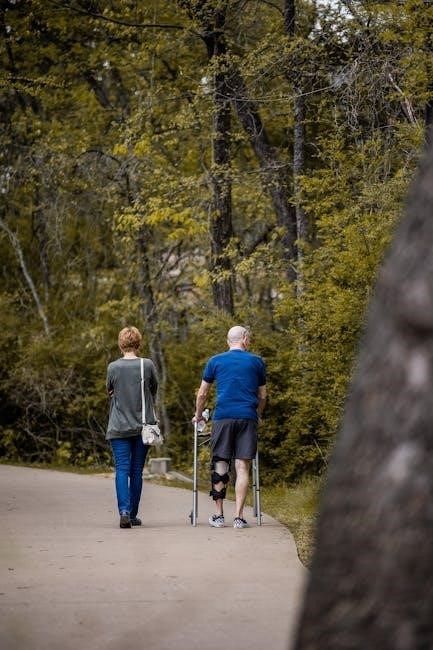
Achilles tendon rupture rehabilitation is a structured process focusing on restoring strength, mobility, and function. It involves phased recovery strategies, personalized exercises, and consistent monitoring to ensure optimal outcomes and prevent re-injury.
1.1 Understanding the Importance of Rehabilitation
Rehabilitation is crucial for restoring Achilles tendon function after a rupture. It ensures proper healing, minimizes complications, and prevents long-term disability. A structured rehab program addresses pain, strengthens muscles, and improves mobility. Consistency and patience are key, as rushing recovery can lead to re-injury. Effective rehabilitation enables a safe return to daily activities and sports, optimizing overall quality of life.
1.2 Goals of Rehabilitation for Achilles Tendon Rupture
The primary goals of Achilles tendon rupture rehabilitation are to restore tendon strength, improve range of motion, and reinstate normal gait mechanics. Additionally, the program aims to reduce pain, prevent complications, and facilitate a gradual return to pre-injury activities. Achieving these objectives ensures a successful recovery, minimizing the risk of re-injury and enhancing overall functionality and patient satisfaction.
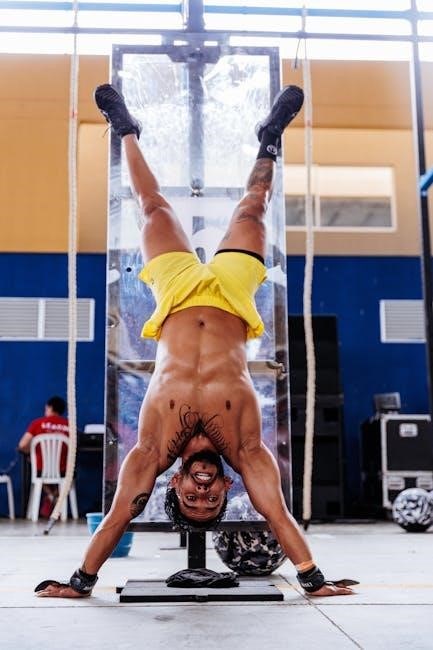
Causes and Risk Factors of Achilles Tendon Rupture
Achilles tendon ruptures often result from sudden stress or direct blows. Risk factors include aging, tight calf muscles, and pre-existing tendon degeneration, increasing vulnerability to injury.
2.1 Common Causes of Achilles Tendon Rupture
Achilles tendon ruptures frequently occur due to sudden, forceful stress on the tendon, such as during abrupt stops or jumps. Direct blows to the tendon, overuse injuries, and pre-existing degeneration also contribute. Risk factors include tight calf muscles, aging, and inadequate warming up. Additionally, chronic inflammation or tendonitis can weaken the tendon, making it more susceptible to rupture. These factors often combine to create a perfect storm that leads to injury, emphasizing the importance of prevention and proper training techniques.
2.2 Identifying Risk Factors for Achilles Tendon Injuries
Several risk factors predispose individuals to Achilles tendon injuries. Age is a significant factor, with incidence increasing after 30 years. Tight calf muscles and poor flexibility contribute to increased tendon stress. Participating in sports involving running, jumping, or sudden directional changes elevates risk. Additionally, inadequate warm-up routines, improper training techniques, and pre-existing tendon degeneration are common contributors. Anatomical issues, such as flat feet, can also alter tendon mechanics. Addressing these factors through targeted exercises and footwear adjustments can help mitigate risk and prevent injuries.
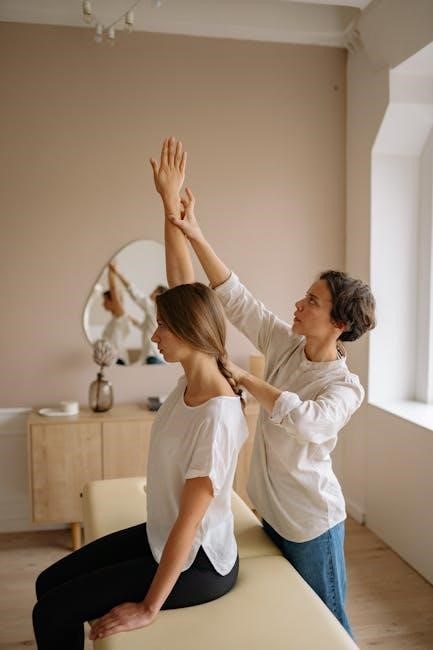
Diagnosis and Initial Assessment
Diagnosis involves clinical evaluation, patient history, and imaging to confirm Achilles tendon rupture. Initial assessment focuses on pain severity, mobility, and functional limitations to guide treatment planning.
3.1 Clinical Examination and Diagnostic Tests
Clinical examination for Achilles tendon rupture involves assessing pain, swelling, and weakness. The Thompson test is commonly used to evaluate tendon integrity. Diagnostic imaging, such as ultrasound or MRI, confirms the rupture’s severity and location, guiding treatment plans. These tests ensure accurate diagnosis, enabling appropriate rehabilitation strategies.
3.2 Role of Imaging in Diagnosing Achilles Tendon Rupture
Imaging plays a crucial role in diagnosing Achilles tendon ruptures. Ultrasound and MRI are commonly used to confirm the extent and location of the injury. These imaging techniques provide detailed visuals of tendon fibers, helping identify partial or complete tears. X-rays may also be used to rule out fractures. Accurate imaging ensures proper treatment planning, whether surgical or non-surgical, and informs the rehabilitation process.
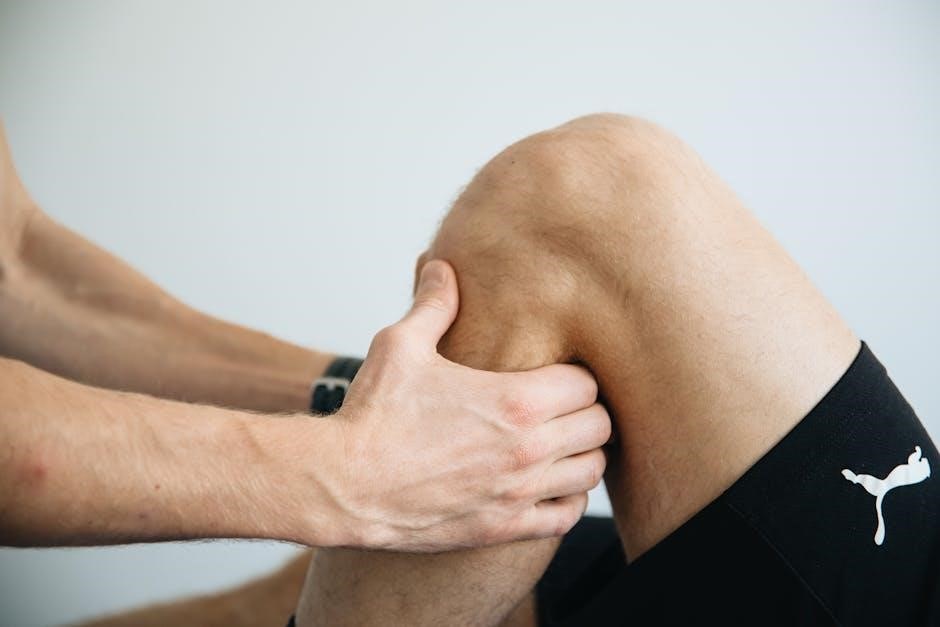
Immediate Care and immobilization
Immediate care involves the RICE protocol and immobilization to protect the tendon, reduce pain, and promote healing. Bracing or splinting is often used to stabilize the ankle.
4.1 RICE Protocol for Acute Achilles Tendon Injuries
The RICE protocol—Rest, Ice, Compression, and Elevation—is critical for acute Achilles tendon injuries. Rest prevents further damage, while ice reduces swelling and pain. Compression, using bandages or braces, supports the tendon, and elevation improves blood flow. This approach minimizes inflammation and promotes healing during the initial recovery phase, ensuring the tendon is protected and positioned for optimal repair.
4.2 Use of Bracing and Orthotics in Initial Recovery
Bracing and orthotics play a crucial role in the initial recovery phase of Achilles tendon rupture. Immobilization devices, such as walking boots or splints, protect the tendon from further stress and promote healing. These devices stabilize the ankle, reducing movement and strain on the injured area. Custom orthotics can also be used to support the foot and ankle, ensuring proper alignment and minimizing discomfort. Proper bracing helps prevent re-injury and creates an environment conducive to natural tendon repair during the acute recovery period.
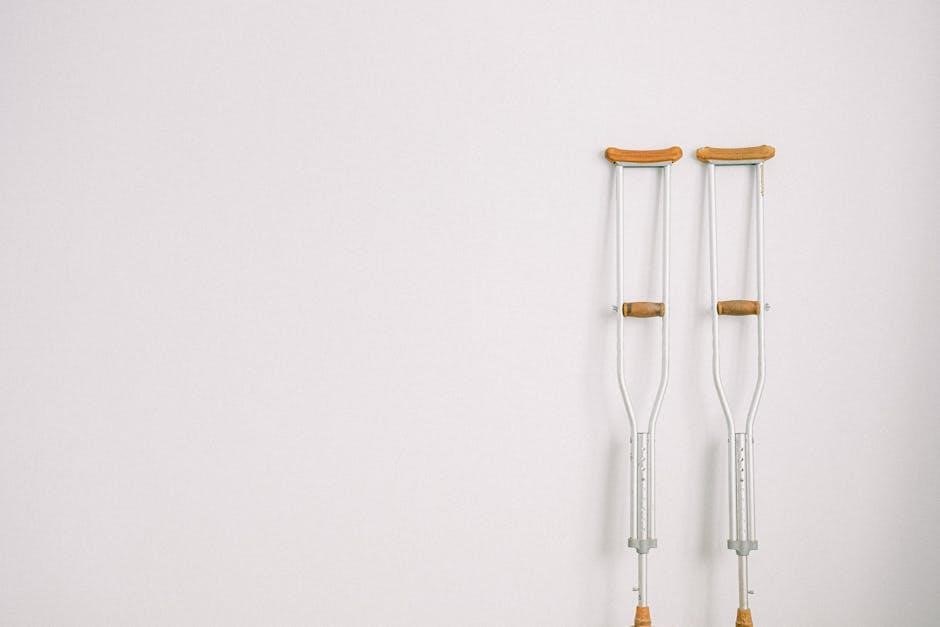
Rehabilitation Process for Achilles Tendon Rupture
The rehabilitation process for Achilles tendon rupture involves a structured program focusing on strength, mobility, and functional recovery. It progresses through phases to ensure safe return to activity.
5.1 Phase 1: 0-2 Weeks Post-Injury (Pain Management and Protection)
Phase 1 focuses on pain management and protecting the tendon. Immediate care includes immobilization, often with a brace or cast, and adhering to the RICE protocol. Patients avoid weight-bearing activities to prevent further damage. Pain is managed with anti-inflammatory medications and ice therapy. Gentle mobilization may begin, but the primary goal is to minimize stress on the tendon, ensuring proper healing. This phase sets the foundation for successful rehabilitation by promoting a stable environment for tendon repair.
5.2 Phase 2: 2-6 Weeks Post-Injury (Mobility and Strength Restoration)
Phase 2 introduces gentle exercises to restore mobility and strength. Patients begin with weight-bearing activities, using braces or orthotics for support. Calf stretches, heel raises, and resistance band exercises are commonly prescribed. The focus is on improving range of motion and strengthening the surrounding muscles without overloading the tendon. Progression is gradual, ensuring the tendon can tolerate increased stress. This phase is critical for preparing the tendon for more dynamic movements in later stages of recovery.
5.3 Phase 3: 6-12 Weeks Post-Injury (Advanced Strengthening and Agility)
Phase 3 focuses on advanced strengthening and agility training. Patients progress to plyometric exercises, such as jump squats and box jumps, to enhance power and explosiveness. Agility drills, like cone exercises and lateral movements, improve coordination and dynamic stability. Resistance band workouts and single-leg balance exercises are also introduced to refine strength and proprioception. This phase emphasizes functional movements, preparing the tendon for high-level activities and sports-specific actions, ensuring a smooth transition to full recovery and minimizing the risk of re-injury.
5.4 Phase 4: Beyond 12 Weeks (Return to Normal Activity)
Beyond 12 weeks, the focus shifts to returning to normal activity and sports. Patients gradually resume pre-injury activities, incorporating high-impact exercises and sports-specific drills. Strength, endurance, and agility are refined through advanced resistance training and plyometric exercises. Functional assessments ensure readiness for unrestricted activity. Emphasis is placed on maintaining tendon health and preventing future injuries through ongoing strengthening and flexibility routines. This phase marks the transition to independence, with patients resuming daily tasks and athletic pursuits confidently.
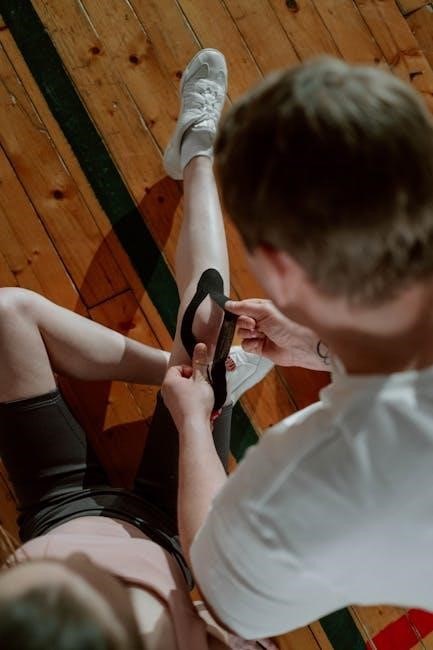
Pain Management Strategies
Pain management for Achilles tendon rupture involves a multimodal approach, combining rest, ice, and anti-inflammatory medications. Early mobilization and gentle exercises help reduce stiffness and discomfort effectively.
6.1 Non-Surgical Approaches to Pain Relief
Non-surgical approaches to pain relief in Achilles tendon rupture rehab focus on reducing inflammation and discomfort. The RICE protocol (Rest, Ice, Compression, Elevation) is often the first line of defense. Bracing and orthotics can provide stability, minimizing strain on the tendon. Physical therapy, including gentle stretching and strengthening exercises, is introduced gradually to promote healing without aggravating the injury. These methods, combined with activity modification, help manage pain effectively during the early stages of recovery.
6.2 Role of Anti-Inflammatory Medications
Anti-inflammatory medications, such as NSAIDs (e.g., ibuprofen, naproxen), play a role in managing pain and swelling during Achilles tendon rupture rehab. These medications can help reduce inflammation and alleviate discomfort, especially in the acute phase. However, their use should be short-term and under medical guidance, as prolonged use may interfere with tendon healing. They are often complemented by other non-surgical strategies to optimize recovery outcomes.
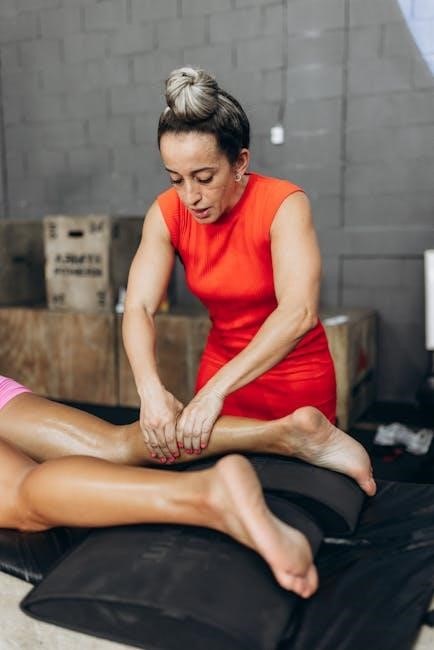
Strengthening Exercises for Achilles Tendon Rehab
Strengthening exercises for Achilles tendon rehab focus on rebuilding calf muscle strength and tendon integrity through controlled movements like heel raises and eccentric exercises to restore function.
7.1 Calf Muscle Strengthening Exercises
Calf muscle strengthening exercises are essential for Achilles tendon rehab, focusing on rebuilding muscle endurance and power. Seated and standing calf raises are foundational, targeting the gastrocnemius and soleus muscles. Eccentric exercises, such as heel drops, emphasize controlled lengthening of the tendon, enhancing strength and resilience. Progressive resistance, using bands or weights, is introduced to challenge the muscles further. These exercises are typically performed 3-4 times weekly, with 3 sets of 15-20 repetitions, ensuring gradual and safe recovery. Consistency and proper form are critical to avoid overloading the tendon.
7.2 Heel Raises and Eccentric Exercises
Heel raises are a cornerstone of Achilles tendon rehabilitation, targeting the calf muscles and tendon. Standing and seated heel raises, with or without resistance, improve strength and flexibility. Eccentric exercises, such as controlled heel drops, focus on the lengthening phase of muscle contractions, enhancing tendon resilience. These exercises are progressed by increasing repetitions, resistance, or single-leg challenges. Regular practice strengthens the tendon and reduces re-injury risk, promoting a gradual return to normal activity. Proper form and gradual progression are essential to avoid overloading the tendon during recovery.
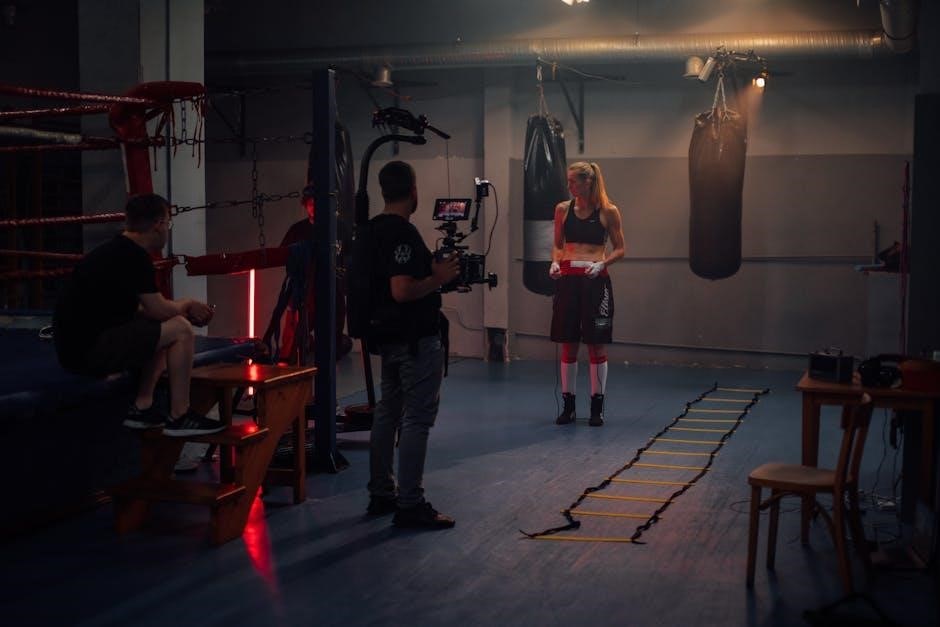
Flexibility and Mobility Exercises
Flexibility and mobility exercises are crucial for restoring Achilles tendon function. Techniques include calf stretches, heel drops, and foam rolling to improve range of motion and reduce stiffness.
8.1 Stretching Techniques for Achilles Tendon and Calf Muscles
Stretching is essential for improving flexibility and reducing stiffness in the Achilles tendon and calf muscles. Common techniques include the standing Achilles stretch, calf stretch, and heel drop exercises. These stretches help lengthen the tendon and muscle fibers, promoting healing and mobility. Dynamic stretches, such as leg swings and high knees, can also be incorporated to enhance range of motion. Consistent stretching routines, combined with foam rolling and self-myofascial release, support long-term recovery and prevent tightness.
8.2 Foam Rolling and Self-Myofascial Release
Foam rolling and self-myofascial release are crucial for alleviating muscle tension and enhancing blood flow to the Achilles tendon and calf muscles. Using a foam roller, apply gentle, sustained pressure to release tight spots in the gastrocnemius and soleus muscles. Slow, controlled movements help reduce scar tissue formation and improve flexibility. These techniques complement stretching exercises, promoting faster recovery and reducing the risk of chronic tightness. Regular self-myofascial release can also prevent adhesions, ensuring smoother tendon glide and overall muscle function during rehabilitation.

Return to Activity and Sports
Return to activity requires gradual progression, ensuring strength, flexibility, and functional recovery. Specific criteria, including pain-free movement and muscle balance, must be met before resuming sports.
9.1 Criteria for Safe Return to Sports
The safe return to sports after Achilles tendon rupture requires specific criteria: pain-free movement, full range of motion, restored muscle strength, and successful functional testing. Athletes must demonstrate stability during dynamic activities and pass clinical assessments to ensure tendon integrity. A gradual progression of intensity and volume is essential to avoid re-injury. Medical clearance and adherence to personalized rehabilitation protocols are also critical. These steps ensure a safe transition back to competitive sports, minimizing the risk of recurrence and optimizing performance levels.
9.2 Gradual Progression of Physical Activity
Gradual progression of physical activity is crucial for a safe recovery. It begins with light exercises, such as heel raises and stretching, and progresses to strength training and functional movements. Activities are increased in intensity and duration based on tolerance and clinical assessment. This approach minimizes stress on the tendon while rebuilding strength and flexibility. Monitoring for pain or instability is essential to avoid setbacks. The progression is tailored to the individual’s healing pace, ensuring a balanced return to normal activity and sports participation.
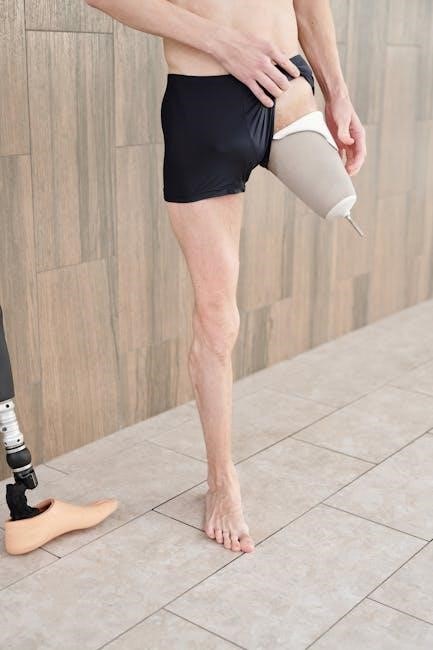
Common Complications and Prevention
Common complications include re-injury, tendon weakness, and chronic pain. Prevention focuses on proper technique, gradual activity progression, and consistent adherence to rehabilitation protocols to ensure long-term recovery and strength.
10.1 Managing Common Complications in Achilles Tendon Rehab
Common complications in Achilles tendon rehab include re-injury, tendon weakness, and chronic pain. Managing these involves monitoring progress, adjusting exercises, and incorporating anti-inflammatory treatments. Proper bracing and orthotics can reduce stress on the tendon, while physical therapy helps restore strength and flexibility. Early detection of issues is crucial to prevent long-term damage. Consistent adherence to rehabilitation protocols and gradual return to activity minimize risks and promote a full recovery.
10.2 Preventing Re-Injury Through Proper Technique
Preventing re-injury requires focus on proper technique during exercises and daily activities. Avoiding overstretching, using correct form in movements, and gradually increasing exercise intensity are key. Strengthening the calf muscles and Achilles tendon through controlled exercises, such as eccentric stretches and heel raises, helps improve resilience. Proper footwear and orthotics can also reduce strain. Consistent adherence to rehabilitation protocols and avoiding high-impact activities until full strength is restored are essential to minimize the risk of re-injury and ensure a durable recovery.
Achilles tendon rupture rehabilitation requires patience, dedication, and consistent adherence to structured exercises and protocols. Effective strategies ensure proper healing, restoring function and preventing future injuries.
11.1 Summary of Key Rehabilitation Strategies
Effective Achilles tendon rupture rehabilitation involves a phased approach, combining pain management, mobility exercises, and progressive strengthening. Early immobilization transitions to weight-bearing activities, followed by calf strengthening, heel raises, and eccentric exercises. Gradual reintroduction of agility drills and sports-specific movements ensures a safe return to activity. Consistency, patience, and adherence to personalized protocols are critical for optimal recovery and preventing re-injury. Proper technique and ongoing monitoring by healthcare professionals further enhance outcomes, fostering long-term tendon health and functional restoration.
11.2 Importance of Consistency in Recovery
Consistency is paramount in Achilles tendon rupture rehabilitation to ensure proper healing and prevent setbacks. Regular adherence to prescribed exercises, therapy sessions, and activity modifications fosters steady progress. Inconsistent efforts can lead to prolonged recovery, increased risk of re-injury, and suboptimal outcomes. Sustained commitment to the rehabilitation plan, even during asymptomatic periods, is essential for achieving full functional recovery and restoring tendon strength. Patience and discipline are key, as the tendon requires time to heal and adapt to increasing demands.
